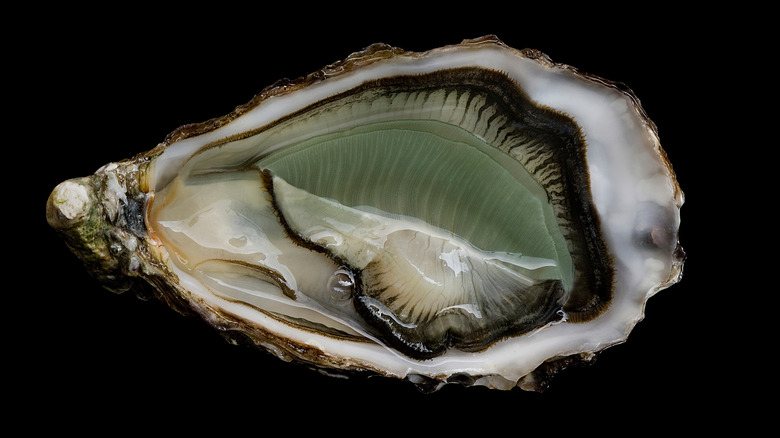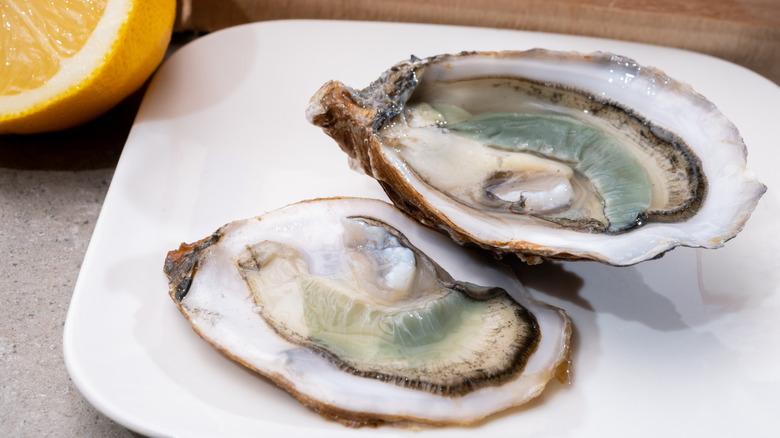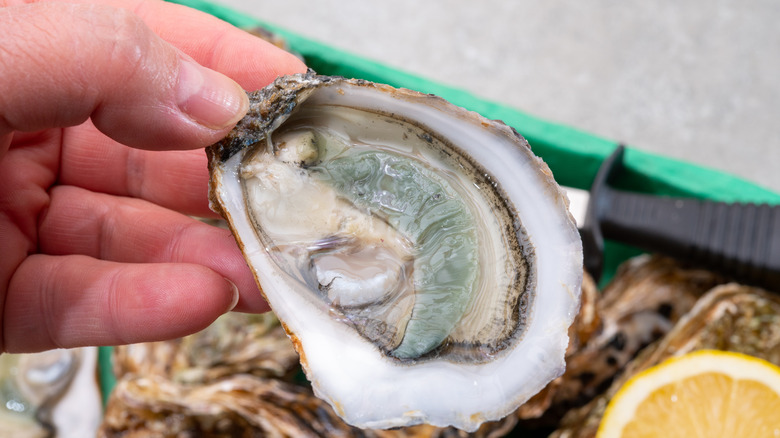Green Gill Oysters Are A Colorful Delicacy Brought To You By Algae
If you have a taste for the rare and unique, green gill oysters need a spot on your bucket list. A seasonal and regional delicacy, these mollusks will take all your expectations for oyster meat and turn them on their heads. Normally, when you think of a green oyster dish, you'd probably think of Oysters Rockefeller, which gets its color from its signature sauce, but with green gill oysters, the actual meat itself has the blue-green hue of seawater. At first, you might balk at the idea of eating green meat of any sort, and you wouldn't be alone. Green gill oysters have flown under the radar in the United States largely because people are wary of the green flesh. But don't let your eyes deceive you. These oysters are perfectly safe to eat and offer an experience unlike any other shellfish.
Green gill oysters have a unique flavor profile that has won fans on multiple continents. They are most singled out for their brininess, which is more noticeable than your average oyster. The salty flavor will be the first thing to hit your tongue, but this is immediately followed by a unique earthy taste that some people compare to mushrooms and truffles. Some diners also note a certain sweetness on the palate and a smooth, creamy texture that your average oyster doesn't possess. What's the secret to these magical mollusks? It's a special type of algae called Haslea ostrearia.
Algae is a part of the oysters' diet
We've all heard the saying, "You are what you eat," but green gill oysters take that wisdom to another level, taking on a pigment from their food. An oyster's diet mainly consists of plankton and algae, and green gill oysters are notable for eating Haslea ostrearia, a type of microalgae. Haslea ostrearia contains marennine, a pigment whose blue-green hue beautifully embodies its ocean environment. As the oysters feed, some of the algae becomes embedded in their gills, something not only responsible for the unique color of green gill oysters but also for their flavor.
Green gill oysters are rare because the algae they eat only thrives under certain conditions. Haslea ostrearia grows in cold water regions, becoming particularly abundant in winter. It needs lots of sunlight to thrive; therefore, it only exists where the water is clear. Since it requires such a specific climate, Haslea ostrearia is restricted to a few Atlantic oysters in just a handful of regions. It is notably harvested in Western France. However, the algae also thrives on the opposite side of the Atlantic, specifically in North Carolina, where green gill oysters also go by Atlantic Emerald, Divine Pine, and Wild Green. In recent years, they have become quite popular among American diners, but this wasn't always the case.
Green gill oysters were once considered undesirable
While today green gill oysters are considered a delicacy in North Carolina, they used to be a hard sell. For decades, oyster harvesters had to sell green gills at low prices, often ending up with a large surplus to throw away. American diners, it seemed, expected oysters to be the pale color you commonly see, and chefs and seafood vendors often dealt with customers who feared that eating green-colored oysters could be dangerous. That misconception is far less common nowadays, and green gill oysters have earned a loyal fanbase in the fine dining world. It's a dramatic shift in perspective, and it's thanks to strategic marketing.
One of the leaders of North Carolina's green gill revolution has been Dave Cessna, an oyster harvester who sports the utterly rad nickname "Clammerhead." Cessna used to face an unsellable surplus of green gill oysters every winter until he decided that the mollusks needed rebranding. He began selling them under the alluring name "Atlantic Emerald" and paired the new moniker with a higher price tag to emphasize their rare, seasonal nature. The tactic worked, and other oyster harvesters followed suit. Another key was selling the oysters directly to fine dining restaurants with established reputations and waitstaff who could educate diners on the nature of the green appearance. The final fortuitous turn of events was the rise of Instagram, where the bright color of green gill oysters makes for a crowd-pleasing post.


